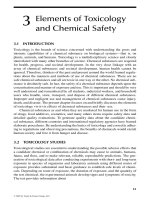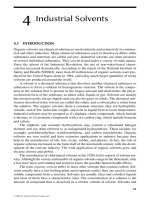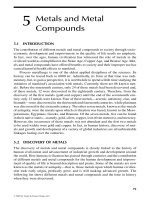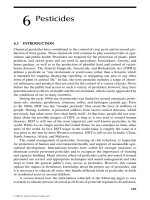SAFE USE OF CHEMICALS: A Practical Guide - Chapter 8 ppt
Bạn đang xem bản rút gọn của tài liệu. Xem và tải ngay bản đầy đủ của tài liệu tại đây (126.67 KB, 12 trang )
161
8
Chemical Substances
and Carcinogenicity
8.1 INTRODUCTION
Progress in a global economy is now primarily based on improved technology and
its distribution to extensive human activities. The global market and production, with
its easy movement and transportation, a less expensive workforce, and less stringent
regulations, have been found to be closely interrelated activities. With these kinds
of situations, human exposure to hazardous chemical substances becomes more
evident. Uncontrolled, irrational transboundary movement of hazardous chemical
substances and waste disposal have caused health hazards in communities. Occupa-
tional and environmental exposure to many chemical substances, industrial solvents,
metals, plastics, and asbestos, such as in mining; shipwrecks, and production and
use of pesticides in agriculture and horticulture, and many others, is known to have
effects on health. To contain any kind of untoward incident at the workplace or in
the community, proper management of hazardous chemical substances is a must. To
achieve this, workers, managers, regulatory agencies and the public at large require
ready information about the good and bad aspects of chemical substances so that
they have proper knowledge.
The following pages provide, in brief, lists of known carcinogens, suspected car-
cinogens, and probable carcinogens. Proper use and careful management of chemi-
cal substances protect human health and safety and the living environment.
8.2 CARCINOGENS AND CARCINOGENESIS
Workers come in contact with a large number of chemical substances in work areas,
as does the general public. The commonly found chemical carcinogens are grouped
under (1) polycyclic aromatic hydrocarbons (PAHs), (2) nitroso compounds, (3)
halogenated hydrocarbons (solvents; e.g., carbon tetrachloride, chloroform, trichlo-
roethylene, and methylene chloride), (4) inorganic metals and minerals (beryllium,
cadmium, nickel, cobalt, chromium, asbestos and arsenic), and (5) naturally occur-
ring chemical substances (aatoxins).
Halogenated hydrocarbons. Several of these compounds are commonly used
as solvents. Examples include carbon tetrachloride, chloroform, trichloro-
ethylene, and methylene chloride.
Inorganic metals and minerals. Several carcinogens are known among met-
als or their salts. Examples of these include beryllium, cadmium, nickel,
© 2009 by Taylor & Francis Group, LLC
162 Safe Use of Chemicals: A Practical Guide
cobalt, and chromium. Only two minerals are known to cause cancer:
asbestos and arsenic.
Naturally occurring. Several naturally occurring carcinogens are known.
Among these is aatoxin, probably the most potent of all carcinogens. Aa-
toxins are produced by molds that grow on peanuts and corn. Other natu-
rally occurring carcinogens are present in sassafras and chili peppers.
Cancer, in fact, has aficted humans around the world and throughout recorded
history. The origin of the word cancer is credited to the Greek physician Hippocrates
(460–370 ), considered the “father of medicine.” Hippocrates used the terms car-
cinos and carcinoma to describe non-ulcer-forming and ulcer-forming tumors. Ber-
nardino Ramazzini, an Italian doctor, reported in 1713 the high incidence of breast
cancer in nuns. Percival Pott of Saint Bartholomew’s Hospital in London described
in 1775 an occupational cancer in chimney sweeps, cancer of the scrotum, caused by
soot collection under the scrotum of workers.
The chemical substances that cause cancer are called carcinogens and the pro-
cess of cancer development is known as carcinogenesis. Cancer occurs when cells
become abnormal and keep dividing and multiplying with more and more cells, with-
out control or order. Over the years, several chemical substances in use have been
categorized as carcinogens or cancer-producing chemical substances. It is hearten-
ing to know that, to date, most known occupational carcinogens are either banned or
well regulated within the respective countries of the world.
Prolonged periods of occupational exposure to toxic chemical substances are
known to increase the risk of developing cancer either by causing mutations in DNA
or by various “epigenetic” mechanisms of promotion (those not involving damage to
DNA), including increased cell proliferation. Most occupational carcinogens discov-
ered to date are mutagens and therefore appear to be cancer initiators. It is important
to learn from the experiences of industrialized countries and prevent the introduction
of newer chemical substances and the production processes that have been found to
be hazardous to human health.
It is important to remember always the statement of Paracelsus in the use and
management of chemical substances: “All chemical substances are poisons and there
is none which is not a poison and only the right dose differentiates a poison and a
remedy.” Carcinogens do not cause cancer in every case. Substances classied as
carcinogens may have different levels of cancer-causing potential. Some may cause
cancer only after prolonged, high levels of exposure. For any particular person, the
risk of developing cancer depends on many factors, including the length and inten-
sity of exposure to the carcinogen and the person’s genetic makeup.
1–5
8.3 CLASSIFICATION OF CARCINOGENS
The most widely used system for classifying chemical substances as carcinogens
comes from the International Agency for Research on Cancer (IARC),
3
which is a
part of the World Health Organization (WHO). During the past 30 years, the IARC
has evaluated more than 900 chemical substances to identify their cancer-causing
potential. The conrmed and suspected carcinogens have been categorized as
© 2009 by Taylor & Francis Group, LLC
Chemical Substances and Carcinogenicity 163
group 1: carcinogenic to humans;r
group 2A: probably carcinogenic to humans;r
group 2B: possibly carcinogenic to humans;r
group 3: unclassiable as to carcinogenicity in humans; andr
group 4: probably not carcinogenic to humans.r
The complete list of agents and chemical substances evaluated by the IARC and their
classications is available in IARC Monographs, volumes 1–98.
3,4,6
The National Toxicology Program (NTP) has listed chemical substances for car-
cinogenicity under two categories:
Known to be a human carcinogen. r There is sufcient evidence of carcino-
genicity from studies in humans.
Reasonably anticipated to be a human carcinogen. r There is limited evi-
dence of carcinogenicity from studies in humans, but sufcient evidence of
carcinogenicity from studies in experimental animals.
A large number of chemical substances are included in group 1 as carcinogenic
to humans. Similarly, the IARC has included many other chemical substances under
group 2, meaning that they are probably carcinogenic to humans. More than 900
agents have been evaluated since 1971 and about 400 chemical substances have been
identied as carcinogenic or potentially carcinogenic to humans. Over half of the
agents classied by the IARC as known, probable, or possible human carcinogens
are primarily occupational.
The types of cancers and the chemical substances closely associated with them
are well known. For instance, exposure to asbestos, radon, inorganic arsenic, chro-
mium, and bis-chloromethyl ether cause lung cancer; vinyl chloride causes liver
cancer and benzene causes leukemia. Some of the occupations, although small in
number, are closely associated with human cancer—for instance, increased risk of
nasal cancer in wood workers, bladder cancer among dye manufacturers, and lung
and nasal cancers among nickel reners. Several types of mineral bers, such as
asbestos, are known to pose a carcinogenic hazard to humans. Also, industrial work-
ers exposed to polycyclic aromatic hydrocarbons formed from the combustion of
fossil fuels are prone to increased risk of lung, skin, and bladder cancer. These sub-
stances are relatively ubiquitous, but exposures are particularly high among workers
in aluminum smelters, gas works, and coke ovens as well as in jobs involving use of
tar and other coal derivatives.
Occupational carcinogens hold a special place among the different classes of
human carcinogens. The occupational environment has been the most fruitful one
for investigating the etiology and pathogenesis of human cancer. It is important to
discover occupational carcinogens because most occupational exposures nd their
way into the general environment, sometimes at higher concentrations than in the
workplace. Industrial workers are at excess risk of cancer, as well documented: scro-
tal cancer among chimney sweeps caused by polyaromatic hydrocarbons (PAHs) in
soot,
3
and lung cancer among asbestos miners. In some instances, the group expe-
rienced excess risk but the causative agent was unknown or at least unproven, as in
© 2009 by Taylor & Francis Group, LLC
164 Safe Use of Chemicals: A Practical Guide
the cases of lung cancer among painters and bladder cancer among workers in the
aluminum industry. The strength of the evidence for an association can vary. There
is not much data on human cancer, although hundreds of chemical substances have
been shown to be carcinogenic in species of laboratory animals.
The overall evaluation of human carcinogenicity is based on the epidemiologic
and animal evidence of carcinogenicity, plus any other relevant evidence on geno-
toxicity, mutagenicity, metabolism, or mechanisms. The epidemiologic evidence,
wherever available, has been given greatest weight. Direct evidence from laboratory
animal data is next in importance, with increasing attention paid to mechanistic
evidence that can inform the relevance of the animal evidence for human risk assess-
ment. Categories for the overall evaluation and how they are derived from human,
animal, and other evidence are shown in Tables 8.1 and 8.2.
Generally, workplace exposures to chemical substances are considered to be at
higher levels than for public exposures. Material safety data sheets (MSDSs) should
always contain an indication of carcinogenic potential. The Report on Carcinogens
(RoC) is an informational scientic and public health document rst ordered by the
U.S. Congress in 1978. This report has identied agents, substances, mixtures, or
exposure circumstances that may pose a hazard to human health by virtue of their
carcinogenicity.
8.4 CHEMICAL SUBSTANCES, OCCUPATIONS, AND CANCER
It has been reported recently that the existing systems of classication of carcinogens
are a matter of worldwide discussion. However, there is agreement that any classi-
cation should distinguish between genotoxic and nongenotoxic chemical substances.
For details refer to the literature.
7
The close association between prolonged use of
TABLE 8.1
Cancer-Causing Chemical Substances and Occupation Affected
Arsenic compounds Glass, metal, and pesticide manufacturing
Asbestos Insulation and textiles industries
Benzene Petroleum industry
Benzidine and cadmium dyes Textile industry
Beryllium and compounds Aerospace and metal industries
Chromium pigments Paint and paint products industries
Fertilizers and pesticides Agriculture, pest control
Organic solvents Industries associated with rubber, textiles
Paint, printing, and industrial cleaning
Metal compounds, cadmium, nickel,
uranium, etc.
Metal and mining industries
Tobacco Tobacco industry
Source: Modied from different sources.
© 2009 by Taylor & Francis Group, LLC
Chemical Substances and Carcinogenicity 165
chemical substances in high concentrations in different occupations leading to can-
cer has become evident (Tables 8.1 and 8.2).
The toxicological effects of a variety of chemical substances vis-à-vis their car-
cinogenicity potentials to animals and humans have undergone progressive changes
during the early years. The evidence is the classication and categorization of carci-
nogenicity in laboratory animals and humans (epidemiological studies). As has been
stated, the U.S. Environmental Protection Agency (U.S. EPA) intends to revise the
cancer guidelines when substantial changes become necessary; as more information
about carcinogenesis develops, the need may also arise to make appropriate changes
in risk assessment guidance. Thus, the terms of denitions have undergone modica-
tions. One of the rst classications of carcinogenicity was made during 1986. After
a decade the classication underwent a slight change in 1996. Further changes were
made in the draft classication of 1999 followed by that in 2007. These updates of
the guidelines over the years have become important for understanding the manner
of behavior of chemical substances that cause cancer in humans.
The classication scheme for cancer was rst introduced in 1986. The U.S.
EPA issued updated guidance, which included a letter system (A–E) for designat-
ing degree of carcinogenic potential. In the guidelines, hazard identication and
the weight-of-evidence process focused on nding tumors in animals and humans.
The carcinogenic potential of agents to humans was characterized by a six-category
alphanumeric classication system as A, B1, B2, C, D, and E.
TABLE 8.2
Organs and the Carcinogens Suspected to be Associated with Them
Bladder cancer Benzidine, tetrachloroethylene, cyclophosphamide, 4-aminodiphenyl, tobacco
smoking, chloraphazine, tetrachloroethylene
Kidney cancer Coke oven emissions, zinc chromate, tetrachloroethylene
Liver cancer Vinyl chloride, aatoxin, alcoholic drinks
Lung cancer Arsenic, asbestos, benzo(a)pyrene, bis(chloromethyl)ether, chromium, nickel
subsulde, zinc chromate, tobacco, mustard gas, uranium, acrylonitrile,
beryllium, cadmium, 1,2-dibromo-3-chloropropane, polyaromatic hydrocarbons
(PAHs)
Mouth cancer Alcoholic drinks, tobacco smoking
Pharynx, larynx,
esophagus cancer
Chewing (mouth only), mustard gas
Prostate cancer Cadmium
Skin cancer Arsenic, benzo(a)pyrene, polyaromatic hydrocarbons, tetrachloroethylene
Sources: American Cancer Society. 2001. Cancer Facts and Figures, 2001. New York: American Cancer
Society; American Cancer Society. 2006. Known and Probable Carcinogens New York: Ameri-
can Cancer Society; Waldron, A. 1983. A brief history of scrotal cancer, British Journal of
Industrial Medicine, 40:390–401.
© 2009 by Taylor & Francis Group, LLC
166 Safe Use of Chemicals: A Practical Guide
The U.S. EPA has categorized chemical substances into six groups of conrmed
or suspected carcinogens:
Group A: human carcinogen.r This group includes agents only with “suf-
cient evidence” from epidemiological studies to support a causal associa-
tion between exposure to the agents and cancer (Appendix 8.1).
Group B: probable human carcinogen.r This group includes agents for
which the weight of evidence of human carcinogenicity based on epide-
miological studies is limited as well as agents for which the weight of evi-
dence of carcinogenicity based on animal studies is sufcient. The group is
divided into two subgroups:
Group B1 includes agents with limited evidence of carcinogenicity
from epidemiological studies (Appendix 8.2).
Group B2 includes agents with sufcient evidence from animal studies
and inadequate evidence or no data from epidemiologic studies.
Group C: possible human carcinogen.r This group includes agents with lim-
ited evidence of carcinogenicity in animals and absence of data in humans.
Group D: not classiable as to human carcinogenicity.r This group
includes agents with inadequate human and animal evidence of carcinoge-
nicity or no data available in animals and/or humans.
Group E: evidence of noncarcinogenicity for humans.r This group includes
agents with no evidence for carcinogenicity in at least two adequate animal
tests in different species or in both adequate epidemiological and animal stud-
ies (Appendix 8.3).
Subsequently, in 1996 the U.S. EPA released “Proposed Guidelines for Carcino-
gen Risk Assessment,” which used descriptive phrases rather than the alphanumeric
classication to classify carcinogenic potential. In the 1996 classication structure,
increased emphasis was placed on discussing characterization of hazard, dose–
response, and exposure assessments. To reduce the uncertainty in describing the
likelihood of harm, the hazard and weight-of-evidence process embraced an analy-
sis of all relevant biological information and emphasized understanding the agent’s
mode of action in producing tumors.
Advanced studies and research on carcinogens and carcinogenicity have pro-
gressed signicantly over the years. In 1999 the U.S. EPA issued draft guidelines
with greater emphasis on risk characterization, discussions for hazard, dose–response
assessment, exposure assessment, and the use of mode of action of the test chemical
substance in the assessment of carcinogenic potential, besides guidelines to con-
sider risks to children. Thus, in 2005 the U.S. EPA recommended the classication
of the “Guidelines for Carcinogen Risk Assessment,” keeping in view the weight-
of-evidence narrative in the cancer risk assessment. These guidelines represent
the culmination of a long development process, replacing the original cancer risk
assessment guidelines of 1986 and 1999. The descriptor indicates a strong evidence
of human carcinogenicity with different combinations of evidence. The descriptor
becomes appropriate with convincing evidence of epidemiology and the causal asso-
ciation between human exposure and cancer. The conditions thus include:
© 2009 by Taylor & Francis Group, LLC
Chemical Substances and Carcinogenicity 167
There is strong evidence of an association between human exposure and r
either cancer or the key precursor events of the agent’s mode of action, but
not enough for a causal association.
There is extensive evidence of carcinogenicity in animals.r
The modes of carcinogenic action and associated key precursor events have r
been identied in animals.
There is strong evidence that the key precursor events that precede the can-r
cer response in animals are anticipated to occur in humans and progress to
tumors, based on available biological information.
Multiple descriptors. More than one descriptor can be used when an agent’s
effects differ by dose or exposure route. For example, an agent or the chemical sub-
stance may be “carcinogenic to humans” by one exposure route, but “not likely to be
carcinogenic” using a route by which it is not absorbed. Also, an agent or the chemi-
cal substance could be likely to be carcinogenic above a specied dose, but not likely
to be carcinogenic below that dose because a key event in tumor formation does not
occur below that dose. Thus, the route of exposure and the concentration of the can-
didate chemical substance modulate the induction of carcinogenesis.
8.5 CHILDREN AND PESTICIDE-INDUCED CANCER
Children are exposed to potential carcinogenic pesticides in various areas of activity,
such as in schools, on playgrounds and lawns, through food and contaminated drink-
ing water, and through parental exposure to pesticides during the child’s gestation
and the preconception stage. Case reports and case control studies have indicated
that pesticides have caused malignancies that include but are not limited to leuke-
mia, neuroblastoma, soft-tissue sarcoma, lymphoma, and cancers of the brain, colon
and rectum, and testes. The studies suggest that children are more sensitive to the
carcinogenic effects of pesticides than adults and, once again, demand the need for
knowledge about the proper use of chemicals.
REFERENCES
1. American Cancer Society. 2001. Cancer facts and gures, 2001. New York: American
Cancer Society.
2. American Cancer Society. 2006. Known and probable carcinogens. New York: Ameri-
can Cancer Society.
3. International Agency for Research on Cancer (IARC). 2004. Monograph: Overall
evaluations of carcinogenicity to humans (updated 2006). Lyons, France: IARC.
4. U.S. Department of Health and Human Services. 2005. Public Health Service, National
Toxicology Progra m. Report on carcinogens, 11th ed. (updated 2006). Atlanta, GA:
Department of Health and Human Services.
5. Agency for Toxic Substances and Disease Registry. 2002. Cancer fact sheet, Atlanta,
GA: Department of Health and Human Services.
6. Ramazzini, B. 1700. De morbis articum diatribe (diseases of workers). Translated by
W. C. Wright, 1964. New York: Hafner.
© 2009 by Taylor & Francis Group, LLC
168 Safe Use of Chemicals: A Practical Guide
7. Bolt, H. M., Foth, H., Hengstler, J. G., and Degen, G. H. 2004. Carcinogenicity cat-
egorization of chemicals—New aspects to be considered in a European perspective.
Toxicology Letters 151 (1): 29–41.
8. U.S. Environmental Protection Agency. 2007. Pesticides: Health and safety evaluation
of pesticides for carcinogenic potential. Washington, D.C.: U.S. EPA.
ADDITIONAL READING
Birnbaum, L. S., and Fenton, S. E. 2003. Cancer and developmental exposure to endocrine
disruptors. Environmental Health Perspectives 111: 389–394.
Davis, J. R., Brownson, R. C., Garcia, R., Bentz, B. J., and Turner, A. 1993. Family pesticide
use and childhood brain cancer. Archives of Environmental Contamination and Toxi-
cology 24: 87–92.
International Agency for Research on Cancer (IARC). 1972–2006. Monographs on the eval-
uation of the carcinogenic risk of chemicals to man, 1972–2006 (multivolume work).
Geneva, Switzerland: World Health Organization.
Pagoda, J. M., and Preston-Martin, S. 1997. Household pesticides and risk of pediatric brain
tumors. Environmental Health Perspectives 105(11): 1214–1220.
U.S. Environmental Protection Agency (U.S. EPA). 2005. Guidelines for carcinogen risk assess-
ment, Risk Assessment Forum EPA/630/P-03/001B. Washington, D.C.: U.S. EPA.
U.S. Environmental Protection Agency (U.S. EPA). 2007. Pesticides: Health and safety evalu-
ation of pesticides for carcinogenic potential. Washington, D.C.: U.S. EPA.
Zahm, S. H., and Blair, A. 1999. Occupational cancer among women. Research status and
methodologic considerations. American Journal of Industrial Medicine 36: 6–17.
Zahm, S. H., and Ward, M. H. 1998. Pesticides and childhood cancer. Environmental Health
Perspectives 106 (Supp.3): 893–908.
Zahm, S. H., Ward, M. H., and Blair, A. 1997. Pesticides and cancer. In Occupational medi-
cine: State of the art reviews. Vol. 12: Pesticides, ed. Keifer M., 269–289. Philadelphia:
Hanley and Belfus, Inc.
© 2009 by Taylor & Francis Group, LLC
Chemical Substances and Carcinogenicity 169
APPENDIX 8.1
K
NOWN HUMAN CARCINOGENS
Aatoxins
Alcoholic beverage consumption
4-Aminobiphenyl
Analgesic mixtures containing phenacetin
Arsenic compounds, inorganic
Asbestos
Azathioprine
Benzene
Benzidine
Beryllium and beryllium compounds
1,3-Butadiene
1,4-Butanediol dimethylsulfonate (busulfan)
Cadmium and cadmium compounds
Chlorambucil
1-(2-Chloroethyl)-3-(4-methylcyclohexyl)-
1-nitrosourea (MeCCNU)
bis(Chloromethyl) ether and technical-grade
chloromethyl methyl ether
Chromium hexavalent compounds
Coal tar pitches
Coal tars
Coke oven emissions
Cyclophosphamide
Cyclosporin A (ciclosporin)
Diethylstilbestrol (DES)
Dyes metabolized to benzidine
Environmental tobacco smoke
Erionite
Estrogens, steroidal
Ethylene oxide
Hepatitis B virus
Hepatitis C virus
Human papilloma viruses: some genital-mucosal
types
Melphalan
Methoxsalen with ultraviolet A therapy (PUVA)
Mineral oils (untreated and mildly treated)
Mustard gas
2-Naphthylamine
Nickel compounds
Oral tobacco products
Silica
Crystalline (respirable size)
Solar radiation
Soots
Strong inorganic acid mists containing sulfuric acid
Tamoxifen
2,3,7,8-Tetrachlorodibenzo-p-dioxin (TCDD)
“Dioxin”
Thiotepa
Thorium dioxide
Vinyl chloride
Ultraviolet radiation
Broad spectrum UV radiation
Wood dust
X-radiation and gamma radiation
Source: U.S. Department of Health and Human Services. 2005. Public Health Service, National
Toxicology Program. Report on Carcinogens, 11th ed. (updated 2006).
© 2009 by Taylor & Francis Group, LLC
170 Safe Use of Chemicals: A Practical Guide
APPENDIX 8.2
G
ROUP B2—PROBABLE HUMAN CARCINOGENS
Acetaldehyde
Acetochlor
Aciuorfen, sodium
Acrylamide
Aldrin
Amitrole
Aniline
Aramite
Azobenzene
Propoxur
bis(Chloroethyl)ether (BCEE)
Cacodylic acid
Captafol
Captan
Carbon tetrachloride
Chlordane
Chlordimeform
Chloroaniline, p-
Chloroform
Cyproconazole
DDD
DDE
DDT
Daminozide (Alar)
Di(2-ethylhexyl)phthalate
Dibromochloropropane (DBCP)
Dibromoethane, 1,2-
Dichloroethane, 1,2-
Dichloromethane
Dichloropropene
Dieldrin
Epichlorohydrin
Ethylene thiourea (ETU)
Folpet
Furmecyclox (Xyligen B)
Haloxyfop-methyl (Verdict)
Heptachlor
Heptachlor epoxide
Hexachlorobenzene (HCB)
Hexachlorocyclohexane
Lactofen
MGK Repellent 326
Mancozeb
Maneb
Metam sodium
Orthophenylphenol and Na salt
Oxythioquinox (Morestan)
Pentachlorophenol
Polychlorinated biphenyls
Procymidone (Sumilex)
Pronamide (Kerb)
Propargite (Omite)
Propylene oxide
Terrazole
Thiodicarb (Larvin)
Toxaphene (Campechlor)
Trichlorophenol, 2,4,6-
Triphenyltin hydroxide
UDMH
Source: U.S. Environmental Protection Agency. 2007. Pesticides:
Health and Safety Evaluation of Pesticides for Carcino-
genic Potential. Washington, D.C.: U.S. EPA.
© 2009 by Taylor & Francis Group, LLC
Chemical Substances and Carcinogenicity 171
APPENDIX 8.3
G
ROUP E—EVIDENCE OF NONCARCINOGENICITY FOR HUMANS
Avermectin B1
Bardac 22
Bentazon (Basagran)
Borax
Boric acid
Boron
Bromuconazole
Bronopol
Butylate (Sutan)
Cadusafos
Chlorpropham (CIPC)
Chlorpyrifos
Coumaphos
Cyromazine
Difenzoquat methyl sulfate
Diubenzuron
Dinocap (Karathane)
Diquat dibromide
Disulfoton (Disyston)
Dithiopyr
Esfenvalerate
Ethion
Fenamiphos (Nemacur)
Fenarimol
Fenbutatin oxide (Vendex)
Fenitrothion (Sumithion)
Fenpropathrin
Fenthion
Fenvalerate (Pydrin)
Flumetsulam
Flumiclorac pentyl
Fluridone
Flutolanil
Fonofos (Dyfonate)
Formetanate hydrochloride
Glyphosate
Glyphosate trimesium
Imazapyr (Arsenal)
Imidacloprid
Maleic hydrazide
Mepiquat chloride
Metalaxyl
Methamidophos
Methomyl
Myclobutanil
Naled (Dibrom)
Nicosulfuron
Oxamyl
Paraquat dichloride
Phorate (Thimet)
Phostebupirim
Picloram (+ salts)
Profenofos
Prometryn
Pyridaben
Pyriproxyfen
Rimsulfuron
Rotenone
Sulfentrazone
Sulfosate
Sulprofos
Tebufenozide
Terbacil
Terbufos
Triasulfuron
Triumizole
© 2009 by Taylor & Francis Group, LLC
172 Safe Use of Chemicals: A Practical Guide
APPENDIX 8.4
C
LASSIFICATION OF BENIGN AND MALIGNANT TUMORS IN MAMMALS
Tissue Benign Tumor Malignant Tumor
Connective Tissue
Adult brous Fibroma Fibrosarcoma
Bone Osteoma Osteosarcoma
Cartilage Chondroma Chondrosarcoma
Embryonic brous Myxoma Myxosarcoma
Fat Lipoma Liposarcoma
Endothelium
Blood vessels Hemangioma Hemangiosarcoma
Lymph vessels Lymphangioma Lymphangiosarcoma
Epithelium
Glandular Adenoma Adenocarcinoma
Squamous Squamous cell papilloma Squamous cell carcinoma
Transitional Transitional cell papilloma Transitional cell carcinoma
Hematopoietic
Bone marrow Not recognized Leukemia
Lymphoreticular
Lymph nodes Not recognized Lymphosarcoma
Muscle
Skeletal muscle Rhabdomyoma Rhabdomyosarcoma
Smooth muscle Leiomyoma Leiomyosarcoma
Nervous System
Glial cells Glioma Malignant glioma
Glioblastoma
Nerve sheath Neurilemmoma Neurogenic sarcoma
© 2009 by Taylor & Francis Group, LLC









